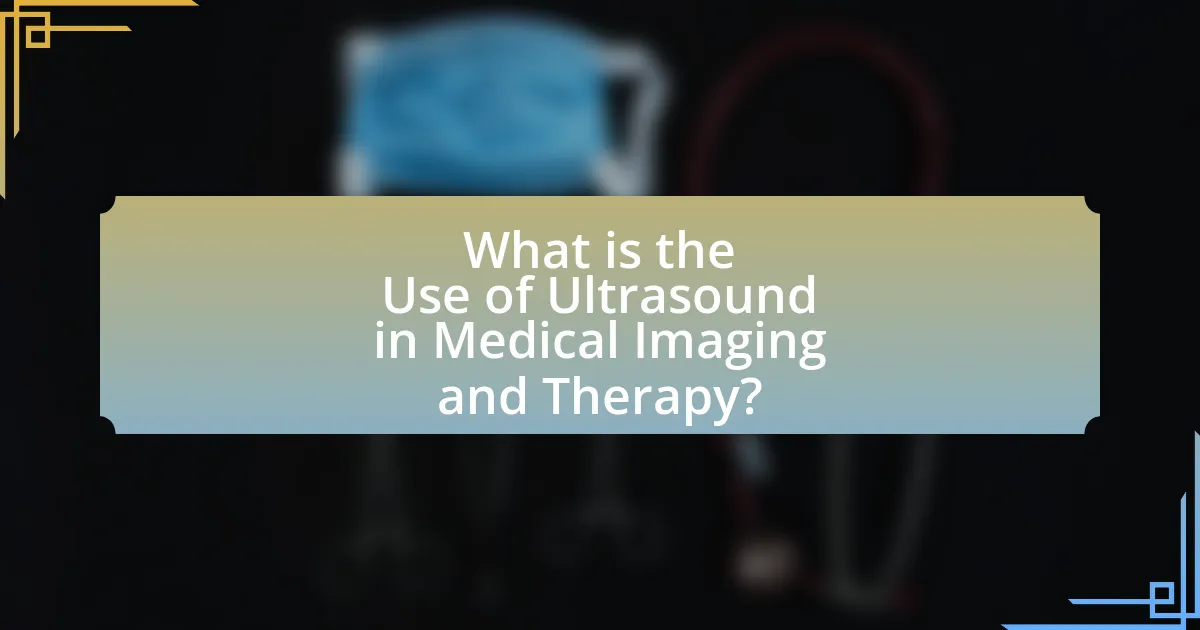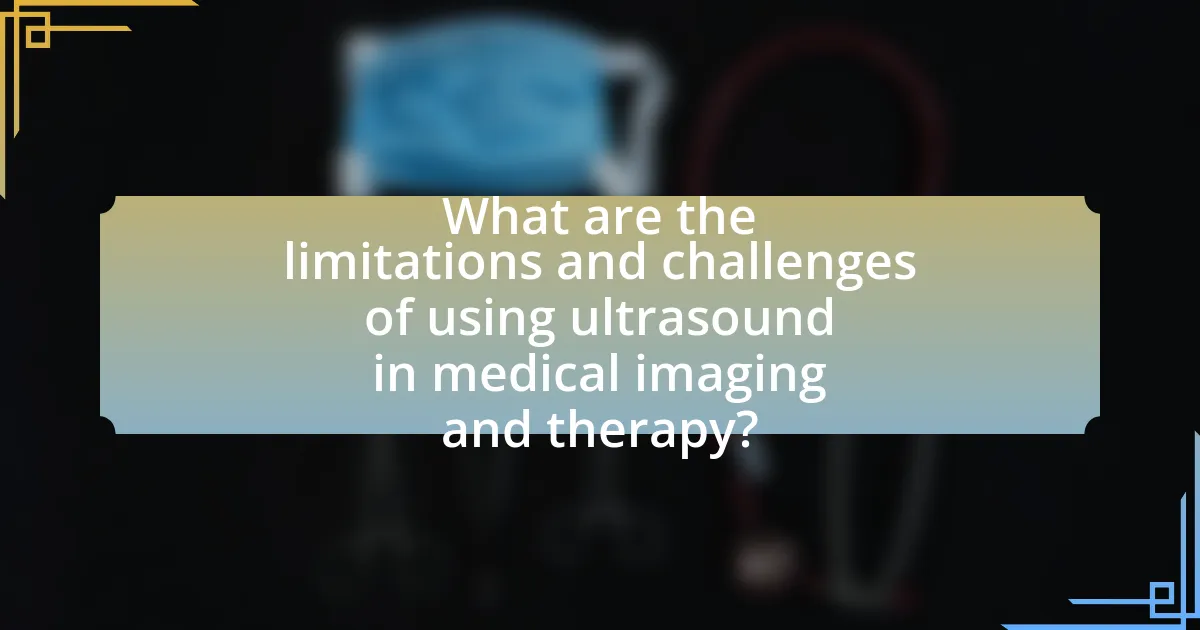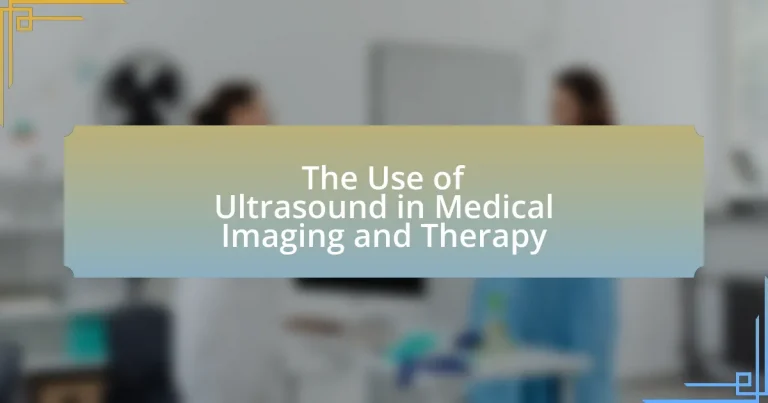Ultrasound is a crucial technology in medical imaging and therapy, utilizing high-frequency sound waves for diagnostic and treatment purposes. It provides real-time visualizations of internal organs, tissues, and blood flow, aiding in the diagnosis of various conditions such as pregnancy and heart diseases. The article explores the functioning of ultrasound technology, its applications in diagnostics and therapy, and the advantages it offers over other imaging modalities, including its non-invasive nature and lack of ionizing radiation. Additionally, it addresses the limitations and challenges of ultrasound, safety considerations, and future trends, including advancements in portable devices and the integration of artificial intelligence.

What is the Use of Ultrasound in Medical Imaging and Therapy?
Ultrasound is used in medical imaging and therapy primarily for diagnostic purposes and treatment applications. In imaging, ultrasound employs high-frequency sound waves to create real-time visualizations of internal organs, tissues, and blood flow, which aids in diagnosing conditions such as pregnancy, gallstones, and heart diseases. For therapy, ultrasound is utilized in procedures like physiotherapy to promote tissue healing and in focused ultrasound surgery to target and destroy tumors non-invasively. The effectiveness of ultrasound in these applications is supported by its ability to provide detailed images without ionizing radiation, making it a safe option for both patients and healthcare providers.
How does ultrasound technology function in medical applications?
Ultrasound technology functions in medical applications by emitting high-frequency sound waves that penetrate body tissues and reflect off internal structures, creating images based on the echoes received. This process, known as sonography, allows healthcare professionals to visualize organs, tissues, and blood flow in real-time without the use of ionizing radiation. For instance, in obstetrics, ultrasound is routinely used to monitor fetal development, providing critical information about the health and growth of the fetus. Additionally, Doppler ultrasound assesses blood flow and can detect abnormalities in vascular structures, demonstrating its versatility in various medical fields.
What are the basic principles of ultrasound imaging?
The basic principles of ultrasound imaging involve the use of high-frequency sound waves to create images of structures within the body. Ultrasound machines emit sound waves that travel through tissues and reflect back to the machine when they encounter different densities, such as fluid, muscle, or bone. The time it takes for the echoes to return is measured and used to construct images, allowing for real-time visualization of organs and tissues. This technique is widely used in medical diagnostics due to its non-invasive nature and lack of ionizing radiation, making it safe for various applications, including obstetrics and cardiology.
How is ultrasound generated and received in medical devices?
Ultrasound is generated in medical devices using piezoelectric crystals that convert electrical energy into mechanical vibrations, producing sound waves. These crystals are typically housed in transducers, which emit ultrasound waves into the body and receive the echoes that bounce back from tissues and organs. The frequency of the ultrasound waves can range from 1 to 20 megahertz, depending on the application, with higher frequencies providing better resolution but less penetration depth. The received echoes are then converted back into electrical signals by the same piezoelectric crystals, allowing for the creation of images or data that can be analyzed for diagnostic purposes.
What are the primary applications of ultrasound in medicine?
The primary applications of ultrasound in medicine include diagnostic imaging, therapeutic interventions, and monitoring of various medical conditions. Diagnostic imaging utilizes ultrasound to visualize internal organs, assess fetal development during pregnancy, and detect abnormalities such as tumors or cysts. Therapeutic interventions involve procedures like ultrasound-guided biopsies and the treatment of conditions such as kidney stones through lithotripsy. Monitoring applications include evaluating blood flow and cardiac function, as well as tracking the progress of certain diseases. These applications are supported by the non-invasive nature of ultrasound, which uses sound waves to create images, making it a safe and effective tool in clinical practice.
How is ultrasound used in diagnostic imaging?
Ultrasound is used in diagnostic imaging primarily to visualize internal body structures, including organs and tissues, through the use of high-frequency sound waves. The ultrasound machine emits sound waves that penetrate the body and reflect off tissues, creating real-time images on a monitor. This technique is widely utilized for assessing conditions in various medical fields, such as obstetrics for monitoring fetal development, cardiology for evaluating heart function, and abdominal imaging for detecting abnormalities in organs like the liver and kidneys. The effectiveness of ultrasound in diagnostic imaging is supported by its non-invasive nature, lack of ionizing radiation, and ability to provide immediate results, making it a preferred choice in many clinical settings.
What therapeutic applications does ultrasound have in medicine?
Ultrasound has several therapeutic applications in medicine, including tissue healing, pain management, and targeted drug delivery. Therapeutic ultrasound promotes tissue repair by enhancing cellular activity and increasing blood flow, which is beneficial in conditions like tendon injuries and muscle strains. Additionally, ultrasound is used in physical therapy to alleviate pain through deep heating of tissues, which can reduce inflammation and improve mobility. Furthermore, ultrasound-guided techniques enable precise delivery of medications to specific areas, enhancing treatment efficacy while minimizing systemic side effects. These applications are supported by clinical studies demonstrating improved recovery times and pain reduction in patients undergoing ultrasound therapy.
What advantages does ultrasound offer compared to other imaging modalities?
Ultrasound offers several advantages compared to other imaging modalities, including real-time imaging, safety, and cost-effectiveness. Real-time imaging allows for dynamic assessment of structures and functions, which is particularly beneficial in guiding procedures such as biopsies or injections. Unlike X-rays or CT scans, ultrasound does not use ionizing radiation, making it a safer option for patients, especially pregnant women and children. Additionally, ultrasound equipment is generally less expensive and more portable than MRI or CT machines, facilitating access to imaging in various healthcare settings. These factors collectively enhance the utility of ultrasound in medical imaging and therapy.
Why is ultrasound considered a safer option for patients?
Ultrasound is considered a safer option for patients because it uses sound waves instead of ionizing radiation to create images of the body. This non-invasive imaging technique minimizes exposure to harmful radiation, which is a significant risk factor associated with other imaging modalities like X-rays and CT scans. Studies have shown that ultrasound does not carry the same risks of radiation-induced complications, making it a preferred choice for monitoring fetal development during pregnancy and assessing various medical conditions.
How does ultrasound provide real-time imaging benefits?
Ultrasound provides real-time imaging benefits by utilizing high-frequency sound waves to create dynamic visualizations of internal structures. This technology allows healthcare professionals to observe physiological processes as they occur, enabling immediate assessment of conditions such as blood flow, organ movement, and fetal development. The ability to visualize these processes in real-time enhances diagnostic accuracy and facilitates timely decision-making during medical procedures. For instance, studies have shown that real-time ultrasound can improve the success rates of needle placements in procedures like biopsies and injections, as it allows for immediate feedback on the needle’s position relative to the target tissue.
How is ultrasound technology evolving in medical practice?
Ultrasound technology is evolving in medical practice through advancements in imaging quality, portability, and artificial intelligence integration. Recent developments have led to higher resolution images and 3D imaging capabilities, enhancing diagnostic accuracy. Portable ultrasound devices are now widely used, allowing for point-of-care assessments in various settings, including emergency rooms and remote locations. Additionally, the incorporation of artificial intelligence algorithms is improving image interpretation and diagnostic efficiency, as evidenced by studies showing AI’s ability to match or exceed human radiologists in certain diagnostic tasks. These advancements collectively enhance patient care and streamline clinical workflows.
What are the latest advancements in ultrasound technology?
The latest advancements in ultrasound technology include the development of portable ultrasound devices, enhanced imaging techniques such as 3D and 4D imaging, and the integration of artificial intelligence for improved diagnostic accuracy. Portable ultrasound devices, like handheld models, allow for greater accessibility in various clinical settings, enabling real-time imaging at the point of care. Enhanced imaging techniques provide more detailed anatomical visualization, which aids in better diagnosis and treatment planning. The incorporation of artificial intelligence algorithms assists radiologists by automating image analysis, reducing interpretation time, and increasing diagnostic precision, as evidenced by studies showing AI’s ability to match or exceed human performance in certain diagnostic tasks.
How are artificial intelligence and machine learning impacting ultrasound imaging?
Artificial intelligence and machine learning are significantly enhancing ultrasound imaging by improving image quality, automating analysis, and facilitating real-time decision-making. These technologies enable advanced algorithms to process and interpret ultrasound data more accurately, leading to better diagnostic outcomes. For instance, studies have shown that AI can reduce the time required for image interpretation by up to 50%, while also increasing diagnostic accuracy by identifying subtle patterns that may be missed by human operators. Additionally, machine learning models can assist in training ultrasound systems to recognize various conditions, thereby streamlining workflows in clinical settings.

What are the limitations and challenges of using ultrasound in medical imaging and therapy?
Ultrasound in medical imaging and therapy has several limitations and challenges, including limited penetration depth, operator dependency, and difficulty in imaging certain tissues. The limited penetration depth restricts ultrasound’s effectiveness in visualizing deeper structures, as high-frequency sound waves attenuate quickly in dense tissues. Operator dependency means that the quality of ultrasound images can vary significantly based on the skill and experience of the technician, potentially leading to misinterpretations. Additionally, ultrasound struggles with imaging air-filled organs and bones, which can create artifacts and obscure diagnostic information. These challenges highlight the need for complementary imaging modalities to enhance diagnostic accuracy and therapeutic effectiveness.
What factors can affect the quality of ultrasound images?
The quality of ultrasound images can be affected by several factors, including the frequency of the ultrasound transducer, the skill of the operator, patient characteristics, and the presence of artifacts. Higher frequency transducers provide better resolution but have limited penetration, while lower frequencies penetrate deeper but offer lower resolution. The operator’s experience significantly influences image acquisition and interpretation, as skilled technicians can optimize settings and positioning. Patient factors such as body habitus, tissue composition, and movement can also impact image clarity. Additionally, artifacts caused by factors like gas, bone, or improper settings can distort images, leading to misinterpretation.
How does patient anatomy influence ultrasound effectiveness?
Patient anatomy significantly influences ultrasound effectiveness by affecting sound wave propagation and image quality. Factors such as body habitus, tissue density, and the presence of air or fat can alter how ultrasound waves travel through the body. For instance, in obese patients, increased adipose tissue can attenuate ultrasound signals, leading to poorer image resolution. Conversely, in patients with less body fat, ultrasound waves can penetrate more effectively, resulting in clearer images. Studies have shown that variations in anatomy, such as organ size and position, also impact the ability to visualize specific structures, thereby affecting diagnostic accuracy.
What are the common technical limitations of ultrasound devices?
Common technical limitations of ultrasound devices include limited penetration depth, resolution constraints, and sensitivity to patient factors. Ultrasound waves can struggle to penetrate dense tissues, such as bone or air-filled structures, which can obscure imaging results. Additionally, the resolution of ultrasound images is often lower compared to other imaging modalities like MRI or CT scans, making it challenging to visualize small or complex structures. Patient factors, such as obesity or the presence of gas in the gastrointestinal tract, can further degrade image quality and complicate interpretation. These limitations are well-documented in medical literature, highlighting the need for complementary imaging techniques in certain clinical scenarios.
What safety considerations should be taken into account when using ultrasound?
When using ultrasound, safety considerations include minimizing exposure time, maintaining appropriate intensity levels, and ensuring proper equipment calibration. Prolonged exposure to ultrasound can lead to thermal and mechanical effects on tissues, which may cause damage. The American Institute of Ultrasound in Medicine recommends adhering to the ALARA (As Low As Reasonably Achievable) principle to limit exposure. Additionally, operators should be trained to use ultrasound equipment correctly to avoid unnecessary risks. Regular maintenance and calibration of ultrasound devices are essential to ensure they operate within safe parameters, as outlined by the FDA and other regulatory bodies.
Are there any risks associated with ultrasound exposure?
Ultrasound exposure is generally considered safe, with minimal risks associated with its use in medical imaging and therapy. Research indicates that there are no known harmful effects from diagnostic ultrasound when used appropriately, as it employs sound waves rather than ionizing radiation. The American Institute of Ultrasound in Medicine states that the benefits of ultrasound typically outweigh any potential risks, especially when performed by trained professionals. However, excessive exposure or inappropriate use may lead to thermal effects or mechanical effects, such as cavitation, but these are rare and usually preventable with proper guidelines.
How can practitioners ensure patient safety during ultrasound procedures?
Practitioners can ensure patient safety during ultrasound procedures by adhering to established protocols and guidelines. These include verifying patient identity, obtaining informed consent, and ensuring the ultrasound equipment is properly maintained and calibrated. Additionally, practitioners should minimize exposure time and use the lowest effective power settings to reduce potential risks associated with ultrasound waves. Evidence from the American Institute of Ultrasound in Medicine indicates that following these safety measures significantly decreases the likelihood of adverse effects during ultrasound examinations.

What future trends can we expect in the use of ultrasound in medicine?
Future trends in the use of ultrasound in medicine include advancements in portable ultrasound devices, enhanced imaging techniques, and integration with artificial intelligence. Portable ultrasound devices are becoming more prevalent, allowing for point-of-care diagnostics and increased accessibility in various healthcare settings. Enhanced imaging techniques, such as 3D and 4D ultrasound, are improving visualization of anatomical structures and facilitating better diagnostic accuracy. Additionally, the integration of artificial intelligence is expected to streamline image analysis, reduce interpretation errors, and assist clinicians in making more informed decisions. These trends are supported by ongoing research and development in ultrasound technology, which aims to improve patient outcomes and expand the applications of ultrasound in clinical practice.
How might ultrasound technology integrate with other imaging techniques?
Ultrasound technology can integrate with other imaging techniques such as MRI and CT scans to enhance diagnostic accuracy and provide comprehensive assessments. This integration allows for the combination of real-time imaging from ultrasound with the detailed anatomical information from MRI or CT, improving the visualization of complex structures. For instance, studies have shown that using ultrasound-guided techniques in conjunction with MRI can increase the precision of biopsies and reduce complications, as evidenced by research published in the Journal of Ultrasound in Medicine, which highlights improved outcomes in targeted interventions.
What role could telemedicine play in the future of ultrasound applications?
Telemedicine could significantly enhance ultrasound applications by enabling remote consultations and real-time image sharing between patients and healthcare providers. This capability allows for quicker diagnoses and treatment plans, particularly in underserved areas where access to specialists is limited. For instance, a study published in the Journal of Telemedicine and Telecare demonstrated that remote ultrasound assessments improved patient outcomes and reduced the need for in-person visits by 30%. Additionally, telemedicine facilitates continuous monitoring of patients through portable ultrasound devices, which can transmit data directly to healthcare professionals, ensuring timely interventions.
How can portable ultrasound devices change patient care delivery?
Portable ultrasound devices can significantly enhance patient care delivery by enabling real-time imaging at the point of care. These devices facilitate immediate diagnosis and treatment decisions, reducing the need for patients to be transported to imaging centers, which can delay care. Studies indicate that portable ultrasound can improve clinical outcomes, particularly in emergency settings, where timely interventions are critical. For instance, a study published in the Journal of Emergency Medicine found that portable ultrasound increased diagnostic accuracy in trauma patients, leading to faster treatment and improved survival rates. Thus, the integration of portable ultrasound into clinical practice transforms patient care by making imaging more accessible and efficient.
What best practices should healthcare professionals follow when using ultrasound?
Healthcare professionals should adhere to best practices such as ensuring proper training and certification in ultrasound techniques, maintaining equipment according to manufacturer guidelines, and following established protocols for patient safety and comfort. Proper training is essential as it enhances the accuracy of diagnoses; studies indicate that trained professionals achieve higher diagnostic accuracy rates. Regular maintenance of ultrasound equipment is crucial to ensure optimal performance and image quality, which directly impacts diagnostic outcomes. Additionally, following protocols for patient safety, such as minimizing exposure time and using appropriate settings, is vital to prevent potential harm. These practices collectively contribute to effective and safe ultrasound use in medical imaging and therapy.
How can practitioners enhance their skills in ultrasound imaging?
Practitioners can enhance their skills in ultrasound imaging through continuous education and hands-on practice. Engaging in specialized training programs, attending workshops, and obtaining certifications in ultrasound techniques are effective methods for skill enhancement. Research indicates that practitioners who participate in simulation-based training demonstrate improved diagnostic accuracy and confidence in their ultrasound abilities. Additionally, regular peer review and feedback sessions can further refine skills and ensure adherence to best practices in ultrasound imaging.
What are the recommended protocols for ultrasound examinations?
The recommended protocols for ultrasound examinations include adherence to established guidelines that ensure patient safety, image quality, and diagnostic accuracy. Key protocols involve proper patient preparation, including fasting if necessary, appropriate positioning, and the use of gel to enhance sound wave transmission. Additionally, operators must follow standardized scanning techniques, such as maintaining consistent transducer pressure and angle, to obtain optimal images. The American Institute of Ultrasound in Medicine (AIUM) provides specific guidelines that emphasize the importance of training and credentialing for sonographers to ensure high-quality examinations. These protocols are validated by studies demonstrating improved diagnostic outcomes when standardized practices are followed.





